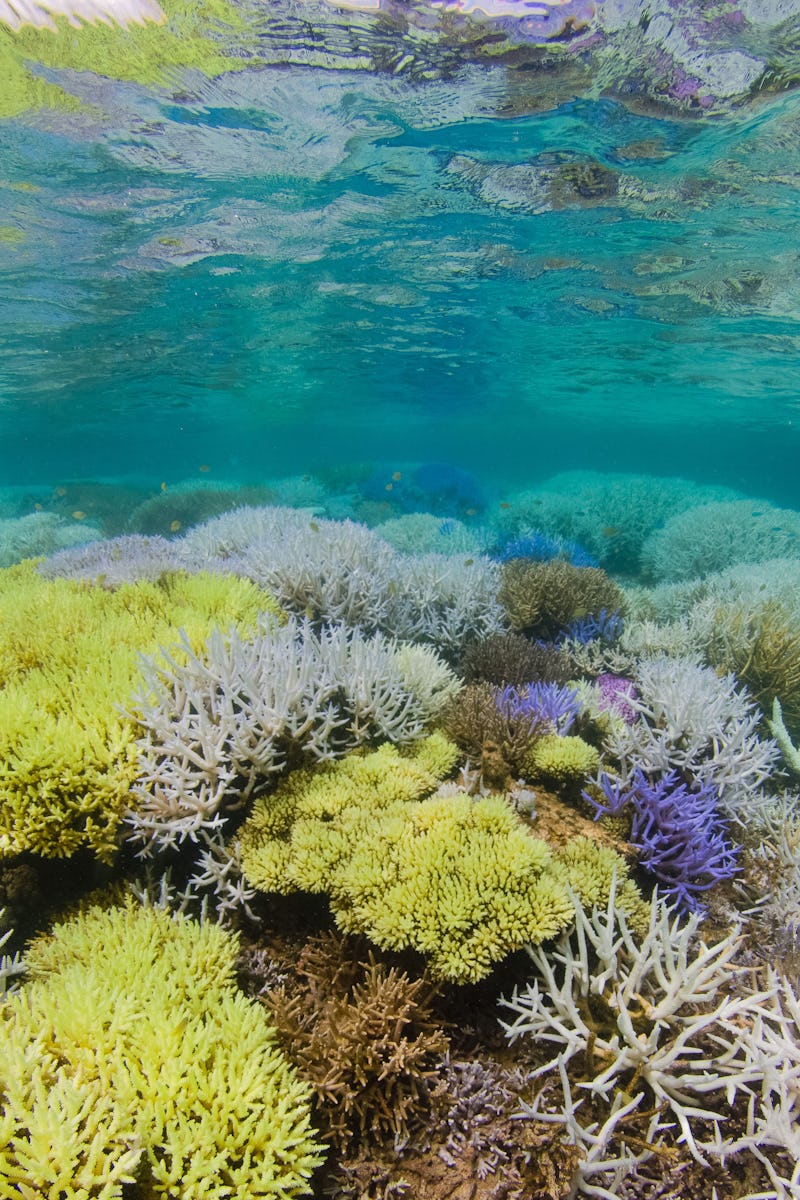
Vibrantly colorful coral revealed as a last-ditch survival response
A new study finds that glowing bluish-purple or neon pink is a reaction some corals have to the effects of climate change. This transformation could help them survive.
by Nina PullanoAround the world, coral reefs are threatened by the climate crisis. Typically, the dying breath of coral is signified by bleaching — an expelling of crucial algae that turns the tissue of coral a ghostly white.
However, in some cases, something spectacular happens instead: In a last-ditch effort to survive, some bleaching corals turn a bright array of neon colors. According to new research, this transformation might actually help reefs rebound.
When coral is healthy, algae live in its cells as part of a symbiotic relationship: The corals provide shelter and nutrients while the algae harness energy with photosynthetic powers. Rising temperatures cause that relationship to waver: Without algae, a stark, bleached skeleton is left behind.
But other corals, and their symbiotic partners, react differently — turning vibrant colors from bluish-purple to dazzling pink.
For the first time, scientists have discovered why: The glow-up is actually the coral and algae adding a protective layer, like sunscreen. This likely helps them weather tough ocean conditions and may also encourage more symbiotic organisms to return to the reef.
These findings were published Thursday in the journal Current Biology.
Acropora corals "bleach" by turning a purple-blue shade.
The colorful protective layer is made up of pigments similar to green fluorescent protein — a substance found in some jellyfish, which glows when exposed to light. It works in what's called an optical feedback loop.
So while the color of coral typically exists because algae live inside the coral's cells, in this case, the coral itself makes the glowing pigment. That ability comes down to interaction with sunlight.
The optical feedback loop explained — In healthy corals, the algae's photosynthesis process absorbs most of the sunlight that hits the reef. Without algae, though, that light is free to bounce around inside the coral instead — the excess light is reflected by the white coral skeleton. All that action is stressful for algae and can dissuade the aquatic plants from returning to the reef.
Acropora corals in the Phillipines, showing colorful bleaching.
But corals have found a way to make that excess light come in handy, too: It helps produce the colorful, photoprotective pigments that act as a "sunscreen layer," explains co-author Jörg Wiedenmann, a professor at the University of Southampton.
The "sunscreen" encourages algae to return, setting some normalcy into motion.
"As the recovering algal population starts taking up the light for their photosynthesis again, the light levels inside the coral will drop and the coral cells will lower the production of the colorful pigments to their normal level," Wiedenmann said in a statement.
This colorful reaction can be seen in coral reefs across the world, including the Great Barrier Reef — the world's largest coral reef.
Colorful coral bleaching happens in reefs across the world's oceans.
The glowing reefs can even be seen on Google Maps.
What's bad for corals is bad for the ocean — Since coral reefs are hotbeds of biodiversity, keeping them intact is important to preserving many of the world's marine animals and plants.
Reefs contain 800 species of hard corals, and they provide resources for around 4,000 species of fish. Ultimately, corals support more species per unit area than any other ocean environment, reports the National Oceanic and Atmospheric Administration.
The authors of the new study say they're encouraged by the colorful coral bleaching because it suggests some patches of reef have a better chance of recovery. In the Great Barrier Reef, for example, a mass bleaching event rocked the reef from March to April 2020. Those corals may be able to rebound if their protective pigments work as scientists hope.
Climate change, however, continues to pose a major threat to corals across the oceans. Scientists emphasize that protecting water quality, and therefore coral reefs, is impossible without a serious commitment to reducing greenhouse gas emissions.
Abstract: Coral bleaching, caused by the loss of brownish-colored dinoflagellate photosymbionts from the host tissue of reef-building corals, is a major threat to reef survival. Occasionally, bleached corals become exceptionally colorful rather than white. These colors derive from photoprotective green fluorescent protein (GFP)-like pigments produced by the coral host. There is currently no consensus regarding what causes colorful bleaching events and what the consequences for the corals are. Here, we document that colorful bleaching events are a recurring phenomenon in reef regions around the globe. Our analysis of temperature conditions associated with colorful bleaching events suggests that corals develop extreme coloration within 2 to 3 weeks after exposure to mild or temporary heat stress. We demonstrate that the increase of light fluxes in symbiont- depleted tissue promoted by reflection of the incident from the coral skeleton induces strong expression of the photoprotective coral host pigments. We describe an optical feedback loop involving both partners of the association, discussing that the mitigation of light stress offered by host pigments could facilitate re- colonization of bleached tissue by symbionts. Our data indicate that colorful bleaching has the potential to identify local environmental factors, such as nutrient stress, that can exacerbate the impact of elevated temperatures on corals to indicate the severity of heat stress experienced by corals and to gauge their post- stress recovery potential.